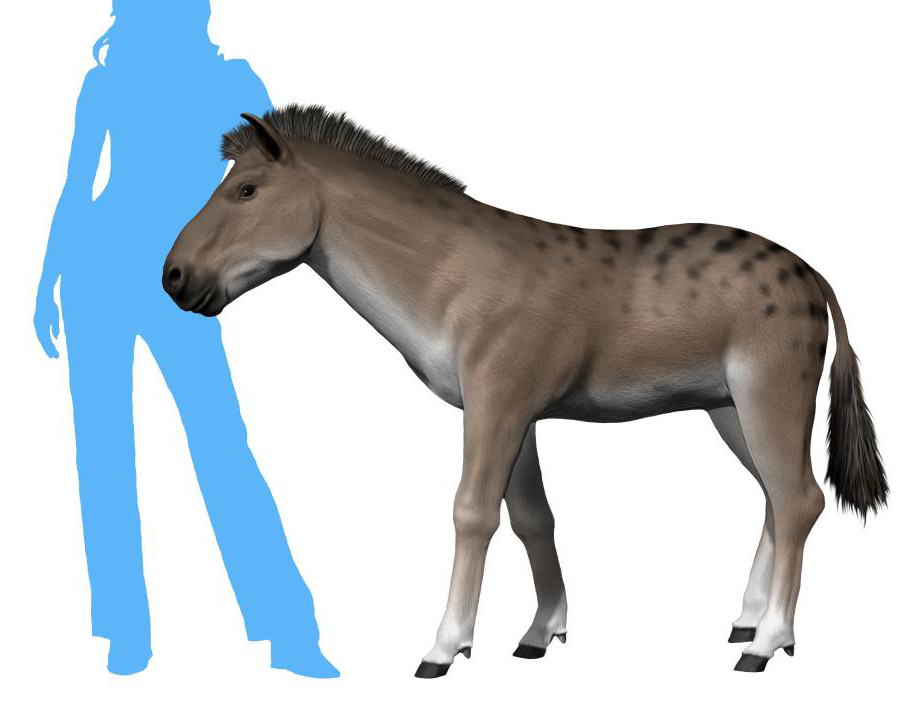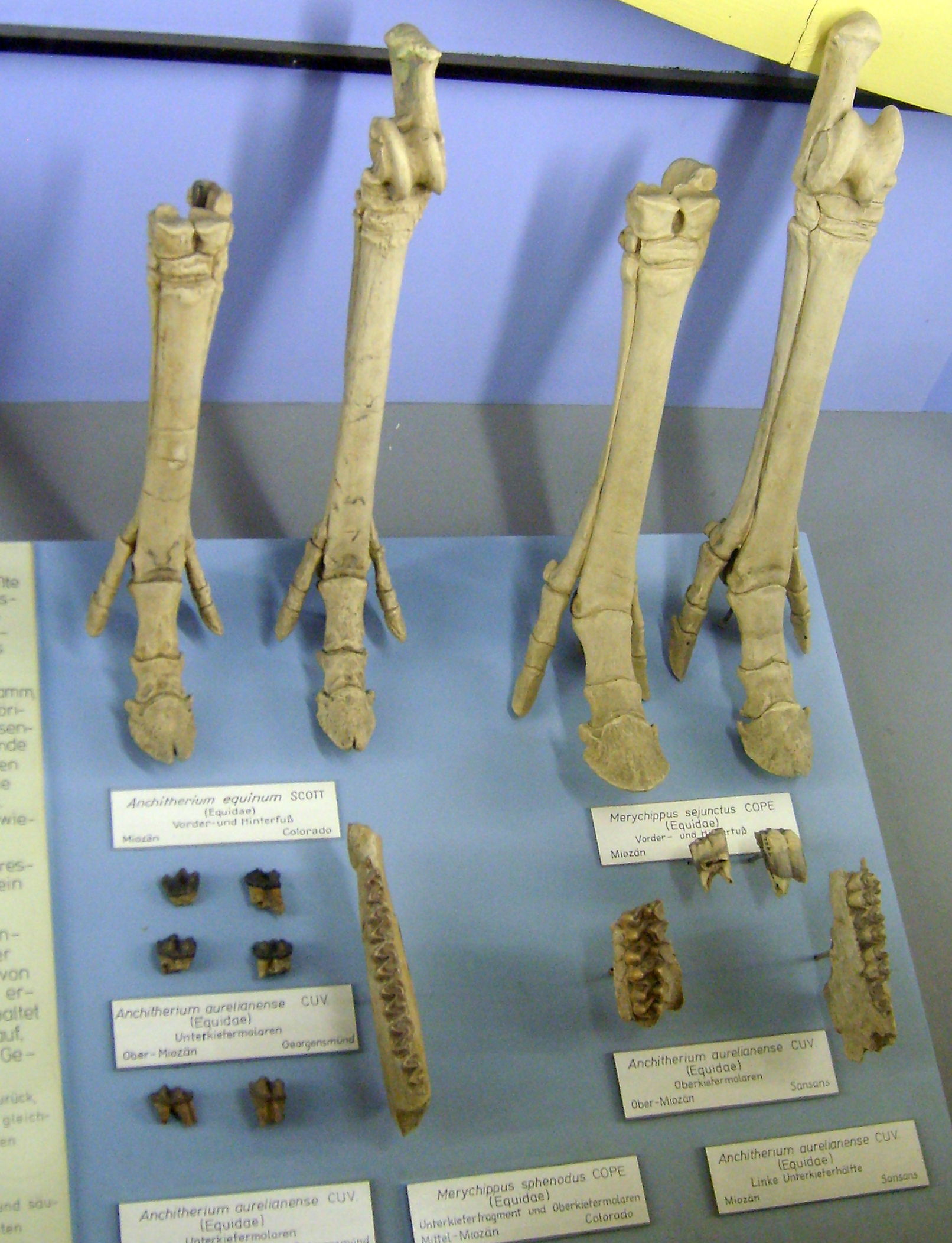Merychippus on:
[Wikipedia]
[Google]
[Amazon]
''Merychippus'' is an extinct proto-
 ''Merychippus'' was named by Joseph Leidy (1856). Numerous authors assigned the type species – ''Merychippus insignis'' – to ''
''Merychippus'' was named by Joseph Leidy (1856). Numerous authors assigned the type species – ''Merychippus insignis'' – to ''
 ''Merychippus'' lived in groups. It was about tall and at the time it was the tallest equine to have existed. Its muzzle was longer, deeper jaw, and eyes wider apart than any other horse-like animal to date. The brain was also much larger, making it smarter and more agile. ''Merychippus'' was the first equine to have the distinctive head shape of today's horses.
The Miocene was a time of drastic change in environment, with
''Merychippus'' lived in groups. It was about tall and at the time it was the tallest equine to have existed. Its muzzle was longer, deeper jaw, and eyes wider apart than any other horse-like animal to date. The brain was also much larger, making it smarter and more agile. ''Merychippus'' was the first equine to have the distinctive head shape of today's horses.
The Miocene was a time of drastic change in environment, with
Photo of a ''Merychippus'' tooth.A classification scheme from The Paleobiology Database
{{Taxonbar, from=Q584323 Miocene horses Miocene odd-toed ungulates Transitional fossils Miocene mammals of North America Prehistoric placental genera Miocene genus first appearances Fossil taxa described in 1856
horse
The horse (''Equus ferus caballus'') is a domesticated, one-toed, hoofed mammal. It belongs to the taxonomic family Equidae and is one of two extant subspecies of ''Equus ferus''. The horse has evolved over the past 45 to 55 million yea ...
of the family Equidae
Equidae (sometimes known as the horse family) is the taxonomic family of horses and related animals, including the extant horses, asses, and zebras, and many other species known only from fossils. All extant species are in the genus '' Equus'', ...
that was endemic to North America
North America is a continent in the Northern Hemisphere and almost entirely within the Western Hemisphere. It is bordered to the north by the Arctic Ocean, to the east by the Atlantic Ocean, to the southeast by South America and th ...
during the Miocene
The Miocene ( ) is the first geological epoch of the Neogene Period and extends from about (Ma). The Miocene was named by Scottish geologist Charles Lyell; the name comes from the Greek words (', "less") and (', "new") and means "less recen ...
, 15.97–5.33 million years ago
The abbreviation Myr, "million years", is a unit of a quantity of (i.e. ) years, or 31.556926 teraseconds.
Usage
Myr (million years) is in common use in fields such as Earth science and cosmology. Myr is also used with Mya (million years ago ...
. It had three toes on each foot and is the first horse known to have grazed.
Discovery and naming
 ''Merychippus'' was named by Joseph Leidy (1856). Numerous authors assigned the type species – ''Merychippus insignis'' – to ''
''Merychippus'' was named by Joseph Leidy (1856). Numerous authors assigned the type species – ''Merychippus insignis'' – to ''Protohippus
''Protohippus'' is an extinct three-toed genus of horse. It was roughly the size of a modern donkey. Fossil evidence suggests that it lived during the Late Miocene (Clarendonian to Hemphillian
The Hemphillian North American Stage on the geolog ...
'', but this is ignored. It was assigned to the Equidae
Equidae (sometimes known as the horse family) is the taxonomic family of horses and related animals, including the extant horses, asses, and zebras, and many other species known only from fossils. All extant species are in the genus '' Equus'', ...
by Leidy (1856) and Carroll (1988), and to the Equinae
Equinae is a subfamily of the family Equidae, which have lived worldwide (except Indonesia and Australia) from the Hemingfordian stage of the Early Miocene (16 million years ago) onwards. They are thought to be a monophyletic grouping.B. J. ...
by MacFadden (1998) and Bravo-Cuevas and Ferrusquía-Villafranca (2006). Its name means "ruminant
Ruminants (suborder Ruminantia) are hoofed herbivorous grazing or browsing mammals that are able to acquire nutrients from plant-based food by fermenting it in a specialized stomach prior to digestion, principally through microbial actions. The ...
horse", but current evidence does not support ''Merychippus'' ruminating.
Description
 ''Merychippus'' lived in groups. It was about tall and at the time it was the tallest equine to have existed. Its muzzle was longer, deeper jaw, and eyes wider apart than any other horse-like animal to date. The brain was also much larger, making it smarter and more agile. ''Merychippus'' was the first equine to have the distinctive head shape of today's horses.
The Miocene was a time of drastic change in environment, with
''Merychippus'' lived in groups. It was about tall and at the time it was the tallest equine to have existed. Its muzzle was longer, deeper jaw, and eyes wider apart than any other horse-like animal to date. The brain was also much larger, making it smarter and more agile. ''Merychippus'' was the first equine to have the distinctive head shape of today's horses.
The Miocene was a time of drastic change in environment, with woodland
A woodland () is, in the broad sense, land covered with trees, or in a narrow sense, synonymous with wood (or in the U.S., the '' plurale tantum'' woods), a low-density forest forming open habitats with plenty of sunlight and limited shade (see ...
s transforming into grass plains. This led to evolutionary changes in the hooves and teeth of equid
Equidae (sometimes known as the horse family) is the taxonomic family of horses and related animals, including the extant horses, asses, and zebras, and many other species known only from fossils. All extant species are in the genus '' Equus' ...
s. A change in surface from soft, uneven mud to hard grassland
A grassland is an area where the vegetation is dominated by grasses ( Poaceae). However, sedge ( Cyperaceae) and rush ( Juncaceae) can also be found along with variable proportions of legumes, like clover, and other herbs. Grasslands occur na ...
s meant there was less need for increased surface area
The surface area of a solid object is a measure of the total area that the surface of the object occupies. The mathematical definition of surface area in the presence of curved surfaces is considerably more involved than the definition of ...
. The foot was fully supported by ligament
A ligament is the fibrous connective tissue that connects bones to other bones. It is also known as ''articular ligament'', ''articular larua'', ''fibrous ligament'', or ''true ligament''. Other ligaments in the body include the:
* Peritoneal l ...
s, and the middle toe developed into a hoof
The hoof (plural: hooves) is the tip of a toe of an ungulate mammal, which is covered and strengthened with a thick and horny keratin covering. Artiodactyls are even-toed ungulates, species whose feet have an even number of digits, yet the rum ...
that did not have a pad on the bottom. In some ''Merychippus'' species, the side toes were larger, whereas in others, they had become smaller and only touched the ground when running. The transformation into plains also meant ''Merychippus'' began consuming more phytolith
Phytoliths (from Greek, "plant stone") are rigid, microscopic structures made of silica, found in some plant tissues and persisting after the decay of the plant. These plants take up silica from the soil, whereupon it is deposited within different ...
rich plants. This led to the presence of hypsodont
Hypsodont is a pattern of dentition with high-crowned teeth and enamel extending past the gum line, providing extra material for wear and tear. Some examples of animals with hypsodont dentition are cows and horses; all animals that feed on gritt ...
teeth. Such teeth range from medium to intense crown height, are curved, covered in large amounts of cement, and are characteristic of grazing
In agriculture, grazing is a method of animal husbandry whereby domestic livestock are allowed outdoors to roam around and consume wild vegetations in order to convert the otherwise indigestible (by human gut) cellulose within grass and ot ...
animals
Equid size also increased, with ''Merychippus'' ranging, on average, between 71 and 100.6 kg.MacFadden, B. J. 1986. Fossil horses from “Eohippus” (''Hyracotherium'') to ''Equus'': scaling, Cope's Law, and the evolution of body size. ''Paleobiology'', 12:355–369.
Classification
By the end of the Miocene era, ''Merychippus'' was one of the first quick grazers. It gave rise to at least 19 different species of grazers, which can be categorized into three major groups. This burst of diversification, termed anadaptive radiation
In evolutionary biology, adaptive radiation is a process in which organisms diversify rapidly from an ancestral species into a multitude of new forms, particularly when a change in the environment makes new resources available, alters biotic in ...
, is often known as the "Merychippine radiation".
The first was a series of three-toed grazers known as hipparions. These were very successful and split into four genera
Genus ( plural genera ) is a taxonomic rank used in the biological classification of living and fossil organisms as well as viruses. In the hierarchy of biological classification, genus comes above species and below family. In binomial nomenclat ...
and at least 16 species
In biology, a species is the basic unit of classification and a taxonomic rank of an organism, as well as a unit of biodiversity. A species is often defined as the largest group of organisms in which any two individuals of the appropriat ...
, including small and large grazers and browsers with large and elaborate facial fossae. The second was a group of smaller horses, known as protohippines, which included ''Protohippus
''Protohippus'' is an extinct three-toed genus of horse. It was roughly the size of a modern donkey. Fossil evidence suggests that it lived during the Late Miocene (Clarendonian to Hemphillian
The Hemphillian North American Stage on the geolog ...
'' and '' Calippus''. The last was a line of "true equines" in which the side toes were smaller than those of other proto-horses. In later genera, these were lost altogether as a result of the development of side ligaments that helped stabilize the middle toe during running.
References
External links
Photo of a ''Merychippus'' tooth.
{{Taxonbar, from=Q584323 Miocene horses Miocene odd-toed ungulates Transitional fossils Miocene mammals of North America Prehistoric placental genera Miocene genus first appearances Fossil taxa described in 1856